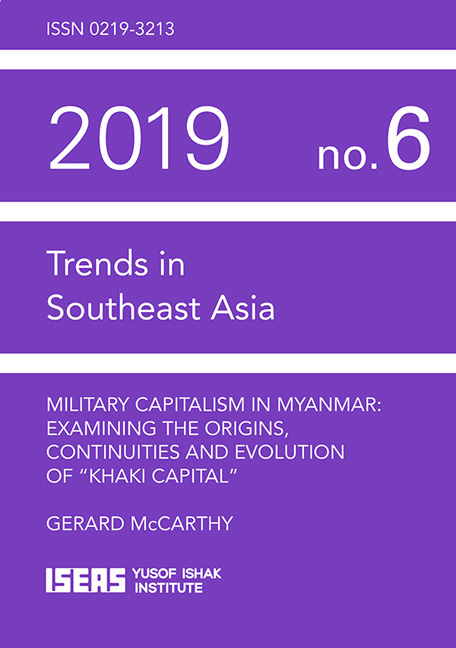Military Capitalism in Myanmar: Examining the Origins, Continuities and Evolution of “Khaki Capital”
Published online by Cambridge University Press: 24 January 2020
Summary
INTRODUCTION
Military conglomerates owned by or linked to state armies are a feature of economic and political systems across Southeast Asia. Often justified by military leaders on the basis of “alleviating” the burden of defence spending on government budgets, these companies can provide sources of funding entirely independent of civilian oversight. Military conglomerates thus commonly serve to entrench the power and autonomy of the armed forces from civilian control despite political transitions to more democratic modes of rule. Extensive scholarly work focused on Southeast Asia and regional contexts including the People's Republic of China and Pakistan has examined and theorized how military commercial interests — or “Khaki Capital” — shapes civilian control over the armed forces. However, the origins, evolution and contemporary implications of military capitalism in Myanmar remain little examined and under-researched.
Myanmar is one of the most highly militarized societies in Southeast Asia and, indeed, the world. If soldiers, veterans and their families alone are considered, the lives of over 3 million people are currently or could in the future be directly shaped by military institutions and conglomerates which dominate major sectors of Myanmar's economy. This report examines the origins and evolution of military capitalism in Myanmar and its contemporary implications for reform of civil–military relations, veteran welfare and the peace process. It draws on interviews with thirty-eight veterans, civil servants, business people, policymakers, researchers and others with experience of military affairs and conglomerates. These interviews were conducted between September and November 2018.
The report is structured in four sections. The first section situates military companies in the context of the political and economic legacies of colonial rule, while the second section examines the re-emergence of military conglomerates after 1988. The third assesses the politics of military companies in contemporary Myanmar, including where they sit in the larger context of shifting civil–military relations. It notes that government pensions appear to be more important in the welfare of the average veterans than the minimal benefit received from military capitalism. The fourth section outlines the role of military capitalism in attempts by the Myanmar government to end conflict since the 1990s, and then examines whether “Business for Peace” initiatives in ceasefire areas are likely to deliver welfare outcomes for average ethnic armed group soldiers, officers and conflict affected communities.
- Type
- Chapter
- Information
- Military Capitalism in MyanmarExamining the Origins, Continuities and Evolution of “Khaki Capital”, pp. 1 - 39Publisher: ISEAS–Yusof Ishak InstitutePrint publication year: 2019

